Ginger ale is a popular soft drink known for its sweet, spicy flavor and smooth fizz. But many people still ask: Does ginger ale have caffeine?
In this post, you’ll find out what’s really in it, how it compares to other sodas, and whether it’s a good choice for your lifestyle.
We’ll also cover its ingredients, health effects, and how to pick a better option at the store. If you drink ginger ale for nausea, flavor, or as a mixer, this guide will help you understand exactly what you’re getting.
What is Ginger Ale?
Ginger ale is a carbonated beverage that’s traditionally made by mixing water, sugar, or high fructose corn syrup with ginger, citric acid, caramel color, and flavoring. Most commercial brands use artificial ingredients, but more natural versions contain fresh ginger root or derived extracts.
You’ll find ginger ale in stores and online, often labeled as flavored soda. Some companies classify it as a soft drink, while others promote more proprietary blends. These include unique combinations of spice and preservatives like sodium benzoate.
There are also traditional styles that are prepared using starter cultures like a ginger bug or even a SCOBY—similar to what’s used in kombucha or sourdough bread. These versions rely on ferments, yeast, and microbial bacteria to create carbonation naturally.
They often grow beneficial yeasts and may even produce subtle, complex flavors that some people say feel more authentic. Whether you consume it with a meal or use it in recipes, ginger ale is typically refreshing. Just know: most ginger ales are made for taste, not therapy.
However, if you prefer real ginger and fewer additives, seek out cane sugar-based or flavored varieties with clear labeling. They’re available—just not always in your local cooler.
Ginger Ale
Main Ingredients:
Ginger, sugar, carbonated waterIced Tea
Typical Caffeine:
15-30mg per cupCola
Typical Caffeine:
34mg per 12oz canDoes Ginger Ale Have Caffeine?
Ginger ale is known for being free from caffeine, but that’s not always the case. While the vast majority of brands like Canada Dry, Seagram, Vernors, Polar, Schweppes, and Sprecher offer caffeine-free versions, it’s smart to check the ingredients list before buying.
Some specialty or niche ales might intentionally include ingredients like guarana, a natural caffeinated additive. Others may have trace amounts due to their brewing process. This includes beverages like ginger beer, which undergoes fermentation and may leave behind a trace of caffeine.
If you’re drinking ginger ale to avoid caffeine, it’s a good habit to read labels. Some versions contain around 25 calories, 10 mg of sodium, and 20–30 grams of sugar per typical serving. While you’re not going to surpass your daily limit with a single can, it helps to know what you’re consuming.
Look for names like Foxon Park, Buffalo Rock, or Shasta — brands known for their clarity. Whether you’re picking a treat for yourself or a mixer for a party, it’s worth knowing the details about that fizzy can in your hand.
Ingredients of Ginger Ale
Carbonated Water
The fizzy base of the beverage, this is what gives ginger ale its refreshing bubbles.
Ginger or Ginger Extract
The signature ingredient. It can be derived from natural ginger root or extract, depending on the brand.
Sweeteners
Ginger ale usually includes various sweets:
- Cane sugar, high fructose corn syrup, or corn syrup in regular versions
- Aspartame or sucralose in diet versions
Acidifiers
These balance the sweetness and preserve the soda’s tart flavor. Common ones include:
- Citric acid
- Phosphoric acid
Flavorings
Brands often enhance taste with flavorings, which may be natural or artificial, and may include fruit essences like lemon or lime.
Preservatives
Used to help the drink stay fresh longer and maintain its quality over time, including:
- Sodium benzoate
- Potassium sorbate
Colorings
Many brands add coloring to give ginger ale a rich golden appearance. Examples include:
- Caramel color
- Synthetic dyes
Types and Variants of Ginger Ale
Ginger ale comes in a range of flavored styles, each tailored to different preferences. Such as:
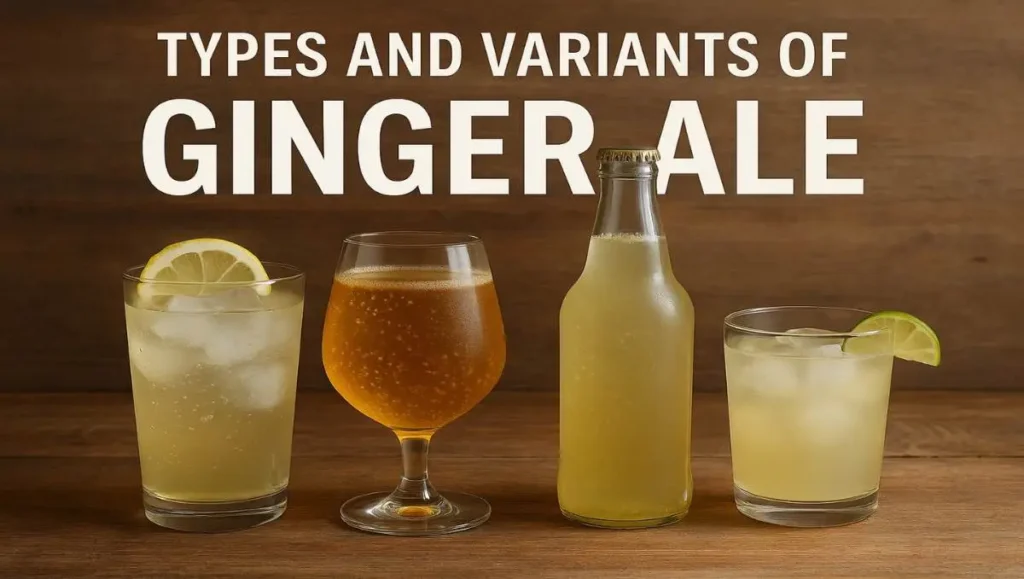
Golden Ginger Ale
Golden ginger ale is the most classic and widely recognized variety. It’s known for its mellow taste, rich caramel undertones, and amber color. This version tends to be sweet, with a focus on bold ginger flavor, though it typically contains artificial sweeteners or sugar depending on the brand.
It’s often the base used in popular flavored or fruit-infused blends. While it’s not fermented, the content and smoothness make it ideal as a standalone drink or mixer. If you enjoy regular soda with a hint of spice, this is the go-to.
Dry Ginger Ale
Dry ginger ale is a sharper, spicier alternative to the golden version. It delivers a lighter, sharper taste with stronger spice notes and noticeable fizz. The dryness is often achieved through selective processing that brings out the heat in ginger without the syrupy sweetness.
It’s great for those who prefer a free-from-sugar experience or want a zesty, bubbly profile. While it may include artificial flavorings, dry ginger ale often leans toward a more natural composition.
Ginger Beer
Though not technically a ginger ale, ginger beer is often mentioned alongside it. This version is fermented, which can result in slight alcohol content (usually less than 0.5%). It’s significantly stronger in flavor, with a peppery kick and cloudy appearance.
Ginger beer is often added to cocktails like the Moscow Mule for its strong, spicy ginger flavor.Some craft options stick to natural ingredients and may skip artificial sweeteners altogether.
Diet Ginger Ale
Diet ginger ale swaps sugar for calorie-free sweeteners, making it a favorite for those watching their intake. While the sweetness is retained, it often has a lighter mouthfeel. This version might use artificial ingredients but gives consumers a free or low-calorie soda option.
Some brands enhance it with additional flavor or even fruit notes to improve taste. If you want to enjoy the fizz without the guilt, diet versions are a solid choice.
Flavored Ginger Ale
Flavored ginger ales are where things get creative. Brands often add fruit like cherry, lemon, or lime to give the drink new dimensions. These twists offer variety beyond the typical ginger flavor, making them popular as mixers or fun soda alternatives.
The color, sweetness, and ingredients may vary, and some versions even include tropical or seasonal variations. If you enjoy variety and new tastes, this is a flavorful way to enjoy something more exciting.
Artisanal or Craft Ginger Ale
Artisanal or craft ginger ales are small-batch sodas that focus on real, natural ingredients and premium quality. These drinks often use ginger root, cane sugar, and spring water, steering away from artificial sweeteners.
They may include unique herbs or regional spice blends, often with a low carbonation level to let the flavors shine. If you’re seeking an elevated experience, craft versions are worth exploring.
Types of Ginger Ale
Regular Ginger Ale
Regular ginger ale includes both traditional and modern sodas. These drinks typically contain ginger, sugar, or high fructose corn syrup and plenty of carbonation. Depending on the brand, you might find other ingredients included, such as acids, preservatives, or additional flavorings.
This style of ginger ale is widely available and often found in both “golden” and “dry” varieties. If you enjoy the classic soda experience with a spice twist, regular ginger ale is a reliable go-to. The best type often depends on your personal taste and preferences.
Dry Ginger Ale
Dry ginger ale is described using the marketing term “dry” to imply a more spicier or drier flavor profile. The flavor is often achieved through how manufacturers source and process the ginger. The result is a crisper, more refined drink with increased carbonation and a sharper finish.
Compared to golden or regular ginger ale, dry versions tend to taste more herbaceous and less sweet, making them popular among adults or as cocktail mixers.
Diet Ginger Ale
Diet ginger ale substitutes sugar with calorie-free sweeteners, like aspartame or sucralose. These beverages cater to those seeking a low-calorie or sugar-free option without giving up flavor.
Some versions may still contain artificial flavorings, but the overall goal is a free-from-calories drink. If you’re monitoring sugar intake or managing your weight, diet ginger ale can offer a guilt-free way to enjoy the fizzy, spicy experience.
Nutritional Information of Ginger Ale
Ginger ale is a carbonated soft beverage that’s typically sweetened and enjoyed chilled. A 12 oz can or bottle of ginger ale delivers around 124 calories per serving, coming mostly from sugar. With about 33 grams of total carbohydrates, it provides energy, but little else nutritionally.
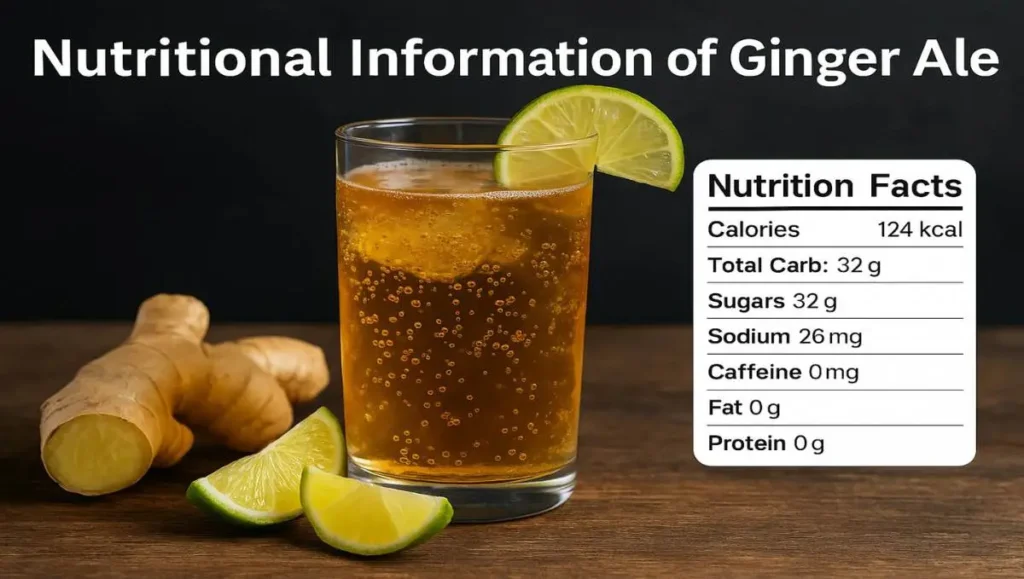
The drink contains zero fat, zero protein, and only small amounts of minerals like sodium (26 milligrams), calcium, iron, and potassium. You won’t find meaningful amounts of dietary fiber, either. Importantly, the caffeine content is zero, which makes it a good option for those avoiding stimulants.
If you’re tracking macros or reading a nutrition label, note that most of the calorie value comes from added sugar, making it a drink best enjoyed in moderation.
| Nutrient | Amount |
| Calories | 124 kcal |
| Total Carbs | 32 g |
| Sugars | 33 g |
| Sodium | 26 mg |
| Caffeine | 0 mg |
| Fat | 0 g |
| Protein | 0 g |
Ginger Ale vs Other Soft Drinks: What’s the Difference?
When you compare ginger ale to other soft drinks, there are a few key factors to look at: caffeine, sugar, flavor profile, and how the drink is used. Most ginger ale is caffeine-free, making it a good alternative to cola or mountain dew, which can be loaded with caffeine and sugar.
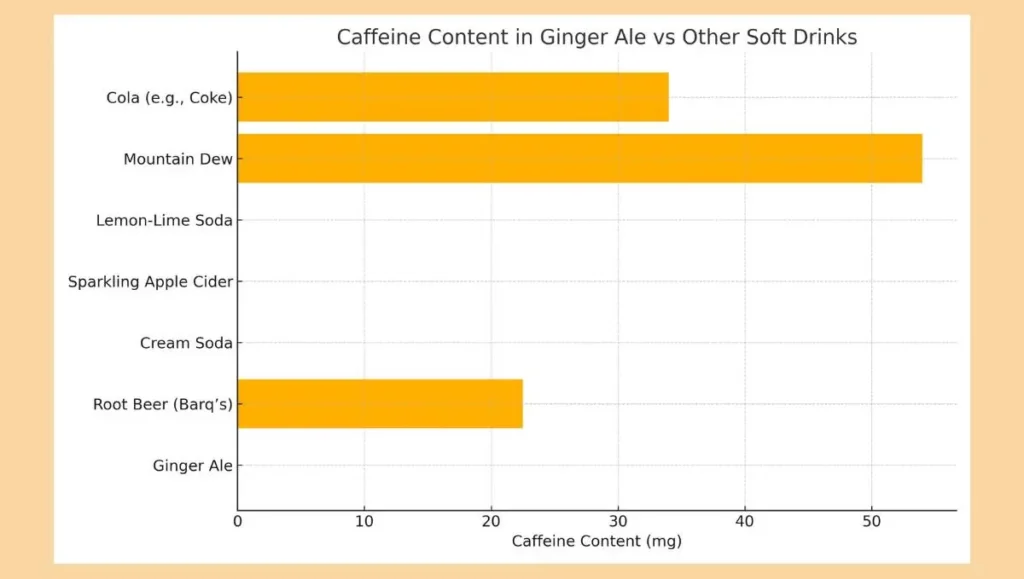
Root beer and cream soda are also sweet, carbonated options, but tend to be more vanilla or herbal in flavor, while lemon-lime soda is citrus-forward. Sparkling apple cider offers a fruity, tangy profile and is a non-caffeinated choice, just like ginger ale. If you prefer something spicy, ginger ale stands out — especially when compared to more neutral or cola-like beverages.
Explore the caffeine content of Baja Blast for a comprehensive comparison.
| Drink | Caffeine | Calories (12 oz) | Flavor Profile |
| Ginger Ale | 0 mg | ~124 kcal | Sweet, spicy |
| Root Beer (Barq’s) | 22.5 mg | ~152 kcal | Sweet, vanilla/herbal |
| Cream Soda | 0 mg | ~150 kcal | Sweet, vanilla |
| Sparkling Apple Cider | 0 mg | ~120 kcal | Fruity, tangy |
| Lemon-Lime Soda | 0 mg | ~140 kcal | Citrus, crisp |
| Mountain Dew | 54 mg | ~170 kcal | Citrus, sweet, sharp |
| Cola (e.g., Coke) | 34 mg | ~140 kcal | Rich, caramel |
Health Benefits of Ginger Ale
While ginger ale may offer mild relief for nausea and hydration, its health benefits depend on the amount of real ginger it contains. Ginger itself is linked to reduced inflammation, migraine relief, and antioxidant support. However, most commercial ginger ales are sugary sodas and should be enjoyed in moderation.
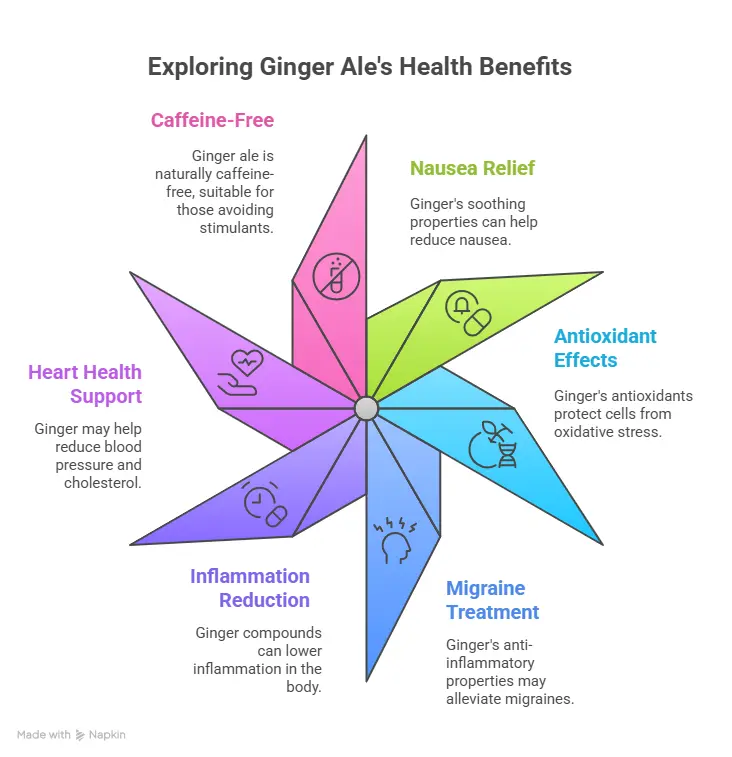
May Help Reduce Nausea
One of the best-known reasons people drink ginger ale is for reducing nausea. This benefit is supported by the natural properties of ginger itself, which is known for soothing the stomach. However, the actual effect depends on the type of ginger ale you consume — some commercial versions may not contain enough real ginger to be effective.
If you’re using ginger ale for health support, check the label. Most soda brands are categorized as sweetened soft drinks, not medicinal beverages, and may not offer the same relief as a ginger tea or supplement would.
May Offer Antioxidant Effects
The antioxidants found in real ginger may help protect cells and reduce oxidative stress. While many studies have shown ginger to be rich in these compounds, the benefits don’t always carry over to commercial versions of ginger ale, especially those made with artificial flavors or little actual ginger content.
Unless you’re drinking a craft or small-batch soda with clearly listed ingredients, it’s unlikely you’ll get significant antioxidants from a can of soda. Still, ginger as a root does contain potent health-boosting properties.
May Help Treat Migraines
Some studies suggest ginger may support treating migraines thanks to its anti-inflammatory and pain-relieving properties. These potential benefits are promising, but again, most ginger ales don’t deliver a therapeutic dose.
Ginger ale might offer minor comfort as a cold, fizzy drink during headaches, but unless it’s made with real ginger, the effectiveness is limited. If migraine relief is your goal, a supplement may work better than soda.
May Help Reduce Inflammation
The root compounds in ginger are linked to lowering inflammation in the body, potentially helping with joint pain and long-term health conditions. However, many commercial ginger ales contain little or no active ginger, so the anti-inflammatory effects may not apply to all brands.
To experience this health benefit, opt for ginger ale that clearly states it uses real ginger or try alternatives like ginger tea. Artificial sweeteners and additives in most sodas may counteract any minor benefits.
May Support Heart Health
Emerging research suggests ginger may help in supporting heart health by reducing blood pressure and cholesterol. While intriguing, these findings are based on concentrated ginger — not soda.
A sweetened, caffeine-free, carbonated soda still offers little direct value for heart support unless you’re consuming versions with high levels of real ginger. So while ginger ale can be enjoyable, it should be consumed in moderation.
Naturally Caffeine-Free
One of the most appealing qualities of ginger ale is that it’s naturally caffeine-free. This makes it a great choice for those avoiding stimulants while still wanting something fizzy and flavorful.
Still, the drink’s categorized status as a soda means it’s often loaded with sweeteners, artificial flavors, and sugar. Check the label to see whether the ginger ale you’re drinking contains real ingredients or is simply flavored.
Ginger vs. ginger ale
The key difference lies in potency: ginger itself is a natural root used in medicine and cooking, packed with antioxidants and anti-inflammatory compounds. Ginger ale, however, is often a sweetened, carbonated soda that may offer the flavors of ginger without its full benefits.
Unless you’re drinking a ginger ale that explicitly says it contains real ginger, you likely won’t get the same health effects. Most store-bought versions include artificial ingredients, and consumed in excess, should still be considered a treat — not a tonic.
Potential Side Effects of Ginger Ale
Although ginger ale is generally safe, drinking it in large amounts can lead to bloating, weight gain, and sugar-related health issues. Diet versions may also affect metabolism or interact with medications due to artificial sweeteners or ginger content.
Bloating and Digestive Discomfort
Ginger ale is a carbonation-based drink that can cause bloating, gas, and discomfort in some people — especially when consumed in large amounts. While fizzy drinks are generally well-tolerated, individuals with gut sensitivities may want to moderate intake.
Sugar and Weight Gain
Most store-bought ginger ales contain a lot of added sugar, which may lead to weight gain and impact overall health if consumed regularly. High sugar intake is linked to chronic diseases such as diabetes and cardiovascular conditions. It’s best to enjoy ginger ale occasionally, not daily.
Artificial Sweeteners and Metabolism
Diet versions of ginger ale contain artificial sweeteners, which some research suggests may affect your metabolism or trigger cravings. Although low in calories, these sweeteners — like sucralose or aspartame — can also impact the gut microbiome in certain people.
Interaction with Blood Thinners
In large amounts, ginger may interact with blood thinners, increasing the risk of bleeding. While most soft drinks contain only trace amounts of ginger (if any), those taking medications should still be cautious when consuming it regularly.
How to Choose a Healthier Ginger Ale?
- Check the ingredient list and nutrition facts panel on the back of the bottle or can to see what’s inside.
- Avoid high fructose corn syrup (HFCS), which is linked to fat production in the liver and altered blood levels. Choose cane sugar instead.
- Watch out for artificial coloring, nonnutritive sweeteners, and extra additives. These may be listed as “sweetener” or “with sweeteners.”
- Look for real ginger on the label. Many ginger ales contain very little actual ginger, reducing any potential health benefit.
- Limit added sugar. Even low-sugar ginger ales are best enjoyed in moderation as part of a well-rounded diet
- Choose a ginger ale that fits your dietary needs and health goals—some are better for low-sugar or clean-label preferences.
- Shop smart by scanning health-focused aisles or product labels for phrases like “low sugar” or “natural.”
Ginger Ale Alternatives and How Much Caffeine They Have?
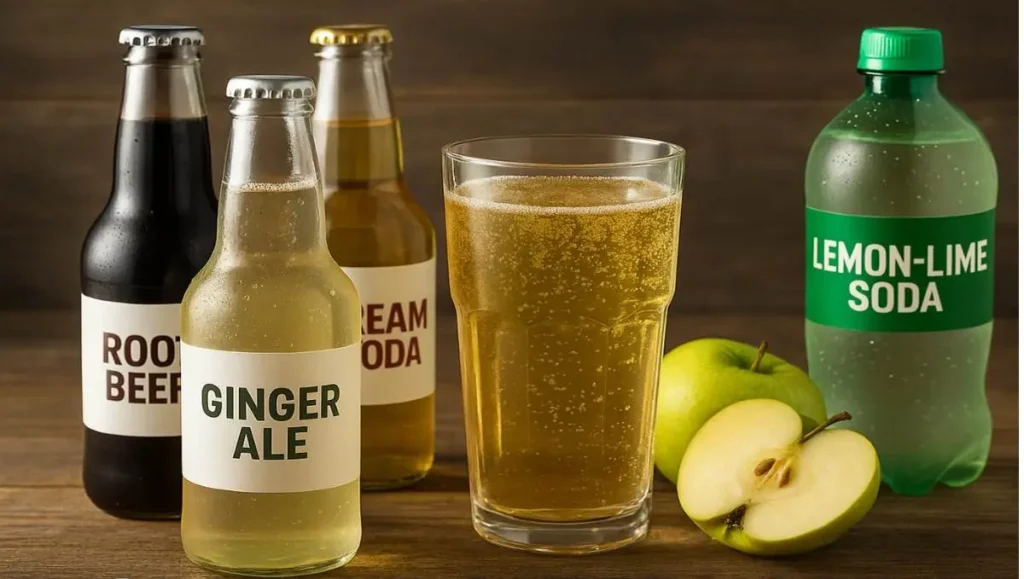
Not a fan of ginger ale or just looking for variety? Here are some carbonated beverage alternatives that are either caffeine-free or contain different amounts of caffeine — each with a unique taste, flavor profile, and fizz.
1. Root Beer
Root beer is a sweet, slightly spicy, carbonated soft drink traditionally derived from sassafras root or artificial extracts. While most root beers are caffeine-free, a few brands, like Barq’s, add caffeine to their formula — about 22 mg per 12 oz serving. People often find the flavor similar to ginger ale, though it has a more distinct, creamy twist.
2. Cream Soda
Cream soda is a vanilla-flavored soft drink known for its sweetness and smooth finish. It’s quite different from ginger ale but shares the carbonation and sweet factor. Most are caffeine-free, though some brands may add a small amount of caffeine.
3. Sparkling Apple Cider
Sparkling apple cider is made from apple juice or cider and has a crisp, fruity, and mildly sweet flavor. It’s a refreshing alternative to ginger ale, often served during celebrations. It’s typically free from caffeine and appeals to those who prefer a natural drink without added stimulants.
4. Lemon-Lime Soda (e.g., Sprite, 7-Up)
Lemon-lime sodas, such as Sprite, are known for their citrusy, crisp taste and carbonated fizz. Though the profile is different from ginger ale, they share similar refreshing qualities. Most are caffeine-free, making them a popular pick for sensitive consumers.
| Drink Option | Caffeine per 12 oz |
| Mountain Dew | 54 mg |
| Barq’s Root Beer | 22.5 mg |
| Lemon-Lime Soda (Sprite/7-Up) | 0 mg (Caffeine-Free) |
| Sparkling Apple Cider | 0 mg (Caffeine-Free) |
| Barq’s Red Cream Soda | 0 mg (Caffeine-Free) |
When Should You Drink Ginger Ale?
Whether for comfort or cocktails, ginger ale fits a variety of situations. Depending on its ingredients, especially whether it contains real ginger, it may provide benefits beyond just being a fizzy treat. Here’s when ginger ale might be the ideal drink.
During Nausea or Motion Sickness
Ginger ale is often used for nausea relief, especially during motion sickness or when dealing with an upset stomach. Its effectiveness depends on whether it contains real ginger, as carbonated beverages without active compounds may not help.
If you’re sensitive to flavors or stomach upset, ginger ale may soothe them, especially if the carbonation is tolerated. Some ales are naturally free from caffeine, making them a safe option during sensitive times.
As a Mixer or Refreshing Drink
Ginger ale is commonly used in cocktails like whiskey ginger or mocktails, offering a sweet, fizzy, and refreshing profile. It’s a great alternative to cola or tonic water, adding spice without heaviness.
You might also consider natural options or low-sugar twists for a healthier experience. The drink not only mixes well but also stands alone as a clean, carbonated pleasure. Offers versatility for those who enjoy beverages with flavor.
While Managing Caffeine Intake
Since most ginger ales are naturally caffeine-free, they’re an excellent substitute for cola-based sodas. They’re useful for avoiding caffeine in the evening or if you’re dealing with sensitivity or trying to reduce intake.
These options are ideal for people managing their caffeine use but still looking for a sweet, natural drink. Some brands even market their products as caffeine-conscious to help you find the right fit.
Myths and Facts About Ginger Ale
There’s a lot of confusion about what ginger ale really is and what it can do. Let’s break down some common myths, misperceptions, and truths to help you make better beverage choices.
“It Always Contains Real Ginger” — Myth
Many commercial brands do not actually contain real ginger. Instead, they may use ginger extract or flavoring, and sometimes only in trace amounts. Check labels carefully — unless it clearly states “real ginger root,” it may only have flavoring.
This myth persists because of marketing, but most ginger ales offer only the flavor, not the benefits of fresh or dried ginger.
“It’s Healthy Because It Says ‘Ginger’” — Myth
It’s easy to think ginger ale is healthy because ginger itself has medicinal benefits. But ginger ale is still a soft drink that often contains sugars, additives, and artificial ingredients.
While ginger may offer some health perks, most commercial versions don’t provide them, especially when made with artificial flavoring or just extract.
“It’s the Same as Ginger Tea” — Myth
Ginger tea is typically made from fresh or dried ginger and may offer true medicinal effects like nausea relief or anti-inflammatory support. In contrast, ginger ale is a soft soda that lacks that direct health impact.
While both contain ginger, they’re not interchangeable. Tea is a health drink, ginger ale is a carbonated beverage with additives and sugars.
“All Ginger Ales Are Caffeine-Free” — Partly True
Most of the ginger ales have zero caffeine, but not all. It’s especially important to check the label on flavored versions or unique blends that may contain caffeine or other added ingredients.
This one is partly true, but always read the labels before assuming — brands differ widely in what they include.
Conclusion
Ginger ale is a carbonated beverage enjoyed for its mild spice and bubbly sweetness — but despite the word “ginger,” not all versions offer health benefits. While most ginger ales are caffeine-free, it’s important to check the label before assuming, especially with flavored or craft variants.
If you’re drinking ginger ale for its supposed health benefits, remember that many commercial versions are loaded with sugar, artificial sweeteners, and contain little or no real ginger. Though traditional varieties made with real ginger root may offer mild benefits like nausea relief, most options are just another soft drink.
Choosing a healthier ginger ale comes down to reading ingredients, comparing nutrition, and staying mindful of your goals. Whether you want a caffeine-free mixer, a soothing soda, or something fizzy and fun, moderation is key.
FAQs
Does ginger ale have caffeine?
Most ginger ales are caffeine-free, but always check the label, especially on flavored or specialty versions.
Is ginger ale good for an upset stomach?
Ginger ale may help soothe mild nausea, but its effectiveness depends on whether it contains real ginger.
What is the difference between ginger ale and ginger beer?
Ginger ale is a lightly flavored, sweet carbonated soft drink, while ginger beer has a bolder, spicier ginger taste and is usually fermented, giving it a more intense flavor profile.
Can children drink ginger ale?
Yes, in moderation. Choose caffeine-free and low-sugar versions to avoid excess sugar and artificial ingredients.
Is ginger ale healthier than cola?
Ginger ale usually has less caffeine than cola, but can be just as high in sugar. Healthier versions are available.

